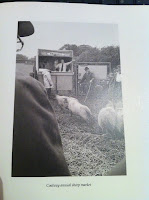‘Rockfalls, Rivermouths & Ponds’ is like
the title suggests, get into the three sections.
'Rockfalls' is set on the beach
at Whale Chine on the Isle of White, where he was originally drawn by the
roaring waves but then he was pulled to the trickle sounds from the cliff face
behind him. He began to discover the tiny rivulets of particles that occasionally
detach themselves from the cliff face and bounce onto the beach below. The more
he stood there, the more he began to notice this becoming a frequent thing.
‘Rivermouths’ began from a desire to
imagine the Earth engulfed by water. The Earth is erased from these
photographs, drowned, as two bodies of water become combined, as the stream
becomes released and flows into the sea, mirroring a psychological movement
when we ourselves become exhausted and give ourselves up to death or something
greater than ourselves.
‘Ponds’ is a project based upon a small pond which is
between two fields and the moor at Woon Gumps in the far west of Cornwall. The
shallow saucer was dug out of the ground a few hundred years ago and has
continually used by cattle, which with their heavy presence have maintained
paths through the gorse and brambles. When they are full, they are like a ‘mirrored
disk or an eye reflecting the heavens’ when empty, they are described as ‘craters
made by celestial objects crashing into the ground.’




